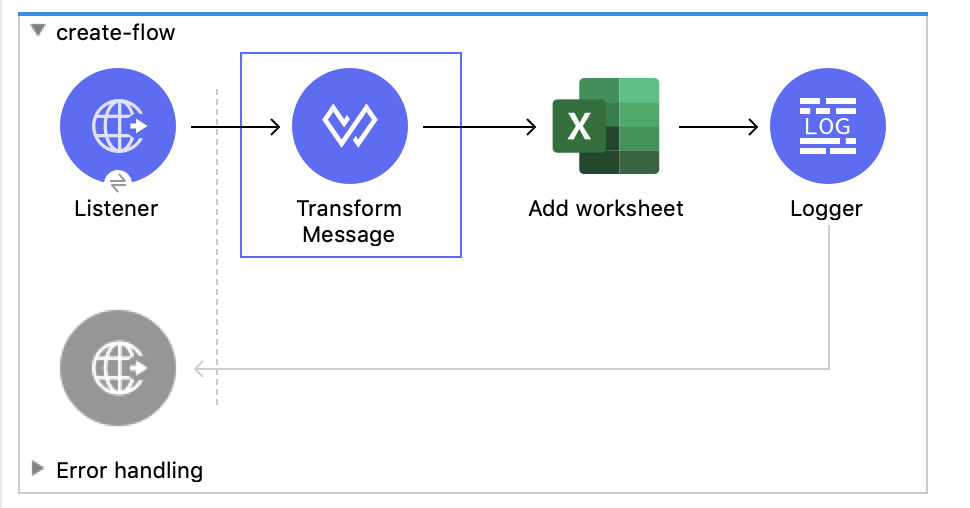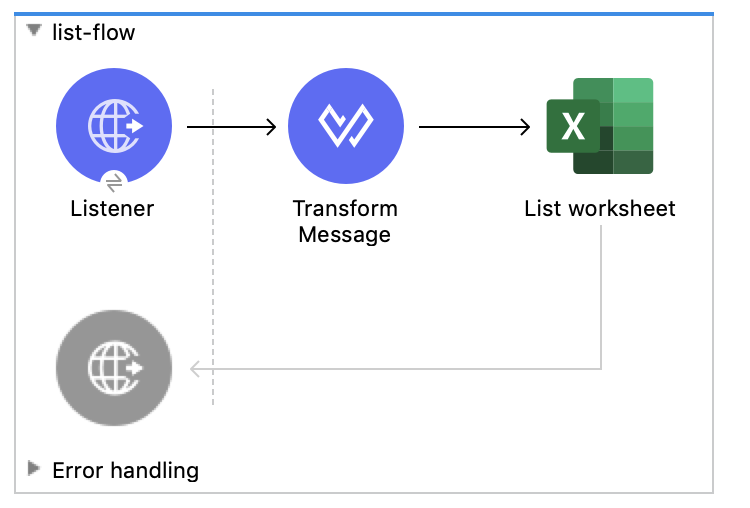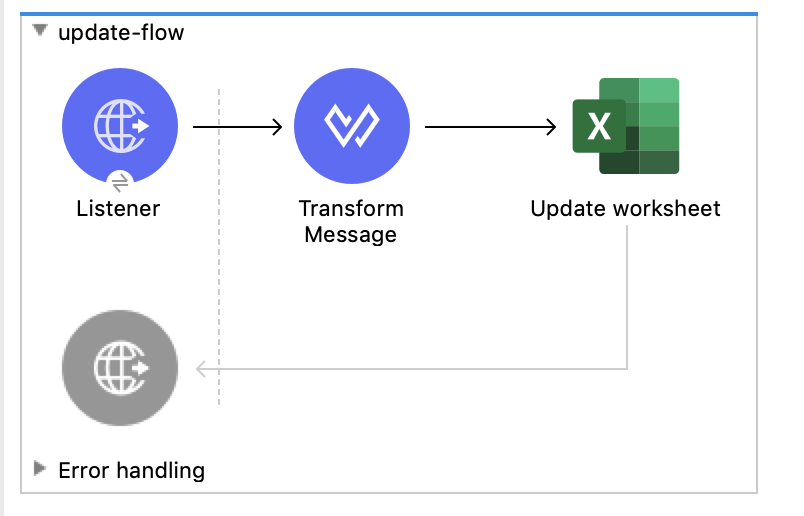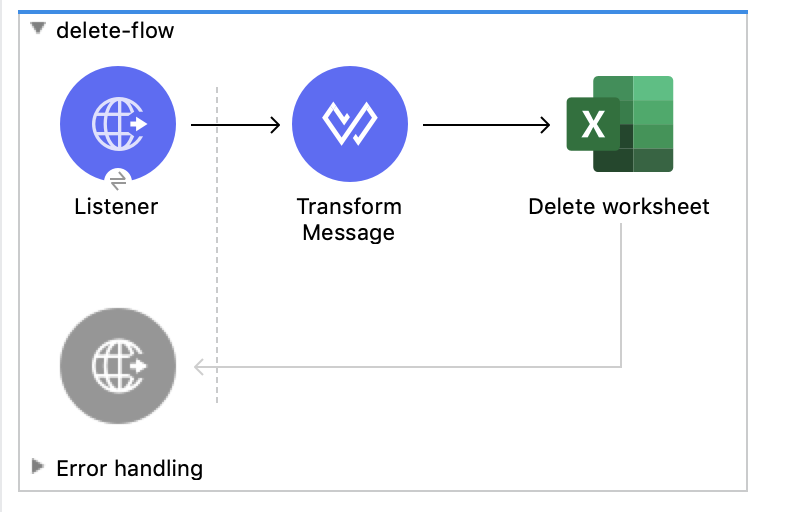config.oauth.authorization.code.consumerKey=<consumerKey> config.oauth.authorization.code.consumerSecret=<consumerSecret> config.oauth.authorization.code.authorizationUrl=<authorizationUrl> config.oauth.authorization.code.accessTokenUrl=<accessTokenUrl>
Microsoft Excel Online Connector 1.1 Examples
This example shows you how to use Microsoft Excel Online Connector to perform the following actions:
Before You Begin
To run this example, you must have:
-
Anypoint Studio 7.3.5 or later
-
Microsoft Excel Online Connector 1.0 or later
-
A working instance of Microsoft Excel Online
Configure OAuth Authorization
Because this connector uses OAuth to secure connections, you must specify OAuth field values, such as client credentials, keys, and OAuth-related URLs. To do this:
-
Create a configuration file for the OAuth connection.
-
Configure the OAuth-related global elements.
-
Configure a global element for the properties file.
Create a Configuration File for the OAuth Connection
Create a configuration file for the OAuth connection that includes properties for the Authorization Code grant type:
-
Create a file named
mule-app.propertiesin the/src/main/resources/folder. -
In the
mule-app.propertiesfile, create a set of properties for theAuthorization Codegrant type, similar to the ones that follow, replacing the bracketed text (including the brackets) with the correct values for your OAuth configuration:
For more information about creating a properties file, see Configuring Property Placeholders.
Configure the OAuth Global Elements
Configure global elements for the OAuth_Authorization_Code_Config file:
-
Create a new Mule project.
-
In the Mule Palette view, click Search in Exchange and enter
microsoft excel. -
Add Microsoft Excel Online Connector to the Selected modules section and click Finish.
-
Click the Global Elements tab and click Create.
-
Select Connector Configuration > Microsoft Excel Online Authorization Code Config and click OK.
-
Enter the following values:
Field Value Name
OAuth_Authorization_Code_ConfigConsumer key
${config.oauth.authorization.code.consumerKey}Consumer secret
${config.oauth.authorization.code.consumerSecret}Authorization url
${config.oauth.authorization.code.authorizationUrl}Access token url
${config.oauth.authorization.code.accessTokenUrl}Scopes
Leave the default:
https://graph.microsoft.com/.defaultListener config
authCallback path
/callbackAuthorize path
authorizePathExternal callback url
http://localhost:8083/callback -
Click OK.
Configure a Global Element for the Properties File
Configure a global element for the mule-app.properties file so that Mule knows where to find it:
-
Click the Global Elements tab and click Create.
-
In the Choose Global Type dialog, select Configuration properties and click OK.
-
In the File field, enter
mule.app.properties. -
Click OK.
Add a Worksheet
The following screenshot shows the Studio app flow for adding a new worksheet:

Adding a new worksheet involves configuring an HTTP Listener component, Transform Message component, Add worksheet operation, and Logger component.
To create the flow:
-
Create a new Mule project in Studio.
-
In the Mule Palette view, search for HTTP and select the Listener operation.
-
Drag the Listener operation onto the canvas.
-
In the Listener configuration, click + next to the Connector configuration field to add a global element.
-
Accept the defaults.
-
In the HTTP properties window, set the Path field to
/create.
Add the Transform Message Component
The first Transform Message component creates a template for the input used to create the team:
-
In the Mule Palette view, search for transform message.
-
Drag the Transform Message component onto the canvas, to the right of the Listener component.
-
In the Transform Message configuration, overlay the brackets in the Output section with this XML:
<ee:set-payload ><![CDATA[%dw 2.0 output application/json --- { workbookId: attributes.queryParams.workbookID, worsheetname: attributes.queryParams.worksheetName }]]></ee:set-payload>
Add the Add Worksheet Operation
The Add Worksheet operation creates a new worksheet based on user input:
-
Drag the Add worksheet operation onto the canvas, to the right of the Transform Message component.
-
In the Add worksheet configuration, click the Connector configuration dropdown and select Microsoft-Excel-Online-Authorization-Code-Config.
-
Select Microsoft_Excel_Online_Authorization_Code_Config as the global element type and click OK.
-
Configure the following fields in the Add worksheet properties window:
Field Value Workbook Id
payload.workbookIdWorksheet Name
payload.worsheetname
List a Worksheet
Create a second flow to list a worksheet. Use the List worksheet operation in this flow:

Update a Worksheet
Create a third flow to update information about a worksheet. Use the Update worksheet operation in this flow:

Delete a Worksheet
Create a fourth flow to delete a worksheet. Use the Delete worksheet operation in this flow:

Run the App
To run the app:
-
Right-click the project in Package Explorer and select Run As > Mule Application.
-
After the app deploys, open a web browser.
-
Enter the following URL to start the OAuth dance:
http://localhost:8081/authorize. -
In the login screen, enter the login information used to access Microsoft Excel Online and click Login.
-
Click Allow.
-
Initiate a flow by entering the associated URL, as shown in the following table:
Flow URL Notes Add a worksheet
http://localhost:8081/create?workbookID={workbookID}&worksheetName={worksheetName}List a worksheet
Update a worksheet
Delete a worksheet
http://localhost:8081/delete?workbookID={workbookID}&worksheetName={worksheetName}
XML for the Examples
Paste this XML code into the Configuration XML tab in your project to experiment with the flows described in the previous sections. When you paste this code, click Yes on the Regenerate 'doc:id' Values dialog.
<?xml version="1.0" encoding="UTF-8"?>
<mule xmlns:ee="http://www.mulesoft.org/schema/mule/ee/core" xmlns:excel="http://www.mulesoft.org/schema/mule/excel"
xmlns:http="http://www.mulesoft.org/schema/mule/http"
xmlns="http://www.mulesoft.org/schema/mule/core" xmlns:doc="http://www.mulesoft.org/schema/mule/documentation" xmlns:xsi="http://www.w3.org/2001/XMLSchema-instance" xsi:schemaLocation="http://www.mulesoft.org/schema/mule/core http://www.mulesoft.org/schema/mule/core/current/mule.xsd
http://www.mulesoft.org/schema/mule/http http://www.mulesoft.org/schema/mule/http/current/mule-http.xsd
http://www.mulesoft.org/schema/mule/excel http://www.mulesoft.org/schema/mule/excel/current/mule-excel.xsd
http://www.mulesoft.org/schema/mule/ee/core http://www.mulesoft.org/schema/mule/ee/core/current/mule-ee.xsd">
<http:listener-config name="HTTP_Listener_config" doc:name="HTTP Listener config" doc:id="b67a7f0e-9d8f-43ee-b3d8-0a2f86fe10c5" >
<http:listener-connection host="0.0.0.0" port="8081" />
</http:listener-config>
<excel:authorization-code-config name="Microsoft_Excel_Online_Authorization_Code_Config" doc:name="Microsoft Excel Online Authorization Code Config" doc:id="a03ea31c-ab5c-4508-ae87-91485d0d9201" >
<excel:oauth-authorization-code-connection >
<excel:oauth-authorization-code consumerKey="${consumerKey}" consumerSecret="${consumerSecret}" authorizationUrl="${authorizationUrl}" accessTokenUrl="${accessTokenUrl}" scopes="${scopes}" resourceOwnerId="${resourceOwnerId}"/>
<excel:oauth-callback-config listenerConfig="HTTP_Listener_config" callbackPath="/callback" authorizePath="/authorize" externalCallbackUrl="http://localhost:8081/callback" />
</excel:oauth-authorization-code-connection>
</excel:authorization-code-config>
<configuration-properties doc:name="Configuration properties" doc:id="2820ecc1-e8be-4b5f-8d6e-5eb3afaf1732" file="mule-app.properties" />
<flow name="create-flow" doc:id="fcdaa88d-173a-4213-aaef-65bdcf384f03" >
<http:listener doc:name="Listener" doc:id="f6a51e00-2be8-4524-9e39-cd4e3387b5e0" config-ref="HTTP_Listener_config" path="/create"/>
<ee:transform doc:name="Transform Message" doc:id="f277839a-9e59-4d2a-9d53-c4d2f012ae90" >
<ee:message >
<ee:set-payload ><![CDATA[%dw 2.0
output application/json
---
{
workbookId: attributes.queryParams.workbookID,
worsheetname: attributes.queryParams.worksheetName
}]]></ee:set-payload>
</ee:message>
</ee:transform>
<excel:add-worksheet doc:name="Add worksheet" doc:id="071f5319-16ae-43dc-9420-bf47479eb3d1" config-ref="Microsoft_Excel_Online_Authorization_Code_Config" workbookId="#[payload.workbookId]" worksheetName="#[payload.worsheetname]"/>
<logger level="INFO" doc:name="Logger" doc:id="9dd54e43-357e-454d-94ff-ccace4bcb580" message="Worksheet ID : #[payload.id]"/>
</flow>
<flow name="list-flow" doc:id="5b1b8836-f3a2-445e-b495-c80d93dcd82d" >
<http:listener doc:name="Listener" doc:id="0ffa794c-37a4-4c57-a14d-da7009fa504f" config-ref="HTTP_Listener_config" path="/list" />
<ee:transform doc:name="Transform Message" doc:id="f71f89a7-0f51-44ba-9e46-18e6f8dcc8c8" >
<ee:message >
<ee:set-payload ><![CDATA[%dw 2.0
output application/json
---
{
workbookId: attributes.queryParams.workbookID
}]]></ee:set-payload>
</ee:message>
</ee:transform>
<excel:list-worksheet doc:name="List worksheet" doc:id="5e576012-f3a1-428a-b20f-d9d5a3442398" config-ref="Microsoft_Excel_Online_Authorization_Code_Config" workbookId="#[payload.workbookId]"/>
</flow>
<flow name="update-flow" doc:id="0cfe6bad-85e8-4e61-9688-52c6b37a93a8" >
<http:listener doc:name="Listener" doc:id="6c874287-c011-4b19-b3e8-55744003f0f6" config-ref="HTTP_Listener_config" path="/update"/>
<ee:transform doc:name="Transform Message" doc:id="d0697ad3-e842-48cd-b0c4-016dd65a712e" >
<ee:message >
<ee:set-payload ><![CDATA[%dw 2.0
output application/json
---
{
name : attributes.queryParams.worksheetUpdateName
}]]></ee:set-payload>
</ee:message>
</ee:transform>
<excel:update-worksheet doc:name="Update worksheet" doc:id="983a65bc-584b-4199-867d-abfb9cf09bcb" config-ref="Microsoft_Excel_Online_Authorization_Code_Config" workbookId="#[attributes.queryParams.workbookID]" worksheetId="#[attributes.queryParams.worksheetName]">
</excel:update-worksheet>
</flow>
<flow name="delete-flow" doc:id="c989f49f-809c-4593-95dc-f93f8634c609" >
<http:listener doc:name="Listener" doc:id="f6e8d004-e264-48c1-85cf-b2ce5a0135d6" config-ref="HTTP_Listener_config" path="/delete"/>
<ee:transform doc:name="Transform Message" doc:id="ea4da82b-cd40-4bf6-b8c7-04efe280d835" >
<ee:message >
<ee:set-payload ><![CDATA[%dw 2.0
output application/json
---
{
workbookId: attributes.queryParams.workbookID,
worksheetName: attributes.queryParams.worksheetName
}]]></ee:set-payload>
</ee:message>
</ee:transform>
<excel:delete-worksheet doc:name="Delete worksheet" doc:id="183fb53f-0c3d-42c2-8676-df485f9a5f43" config-ref="Microsoft_Excel_Online_Authorization_Code_Config" workbookId="#[payload.workbookId]" worksheetId="#[payload.worksheetName]"/>
</flow>
</mule>


